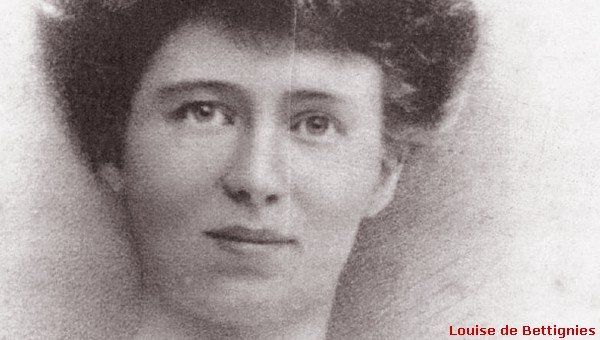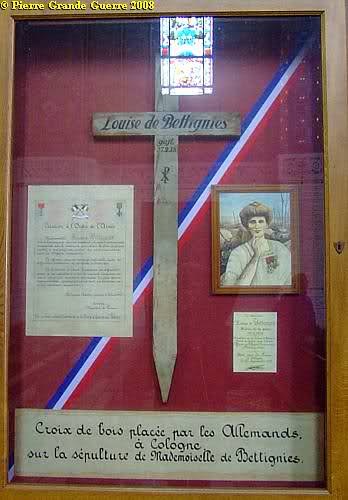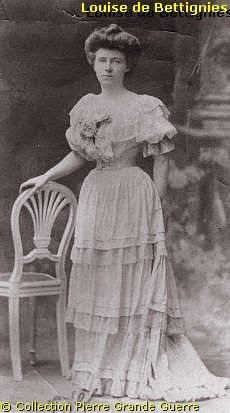Louise de Bettignies - "Queen of English Spies"
DUTCH Page - Column d.d. 10-07-2008

The Queen of English Spies heeft mij de laatste dagen opnieuw beziggehouden. De Koningin der Engelse Spionnen moet een fascinerende vrouw zijn geweest, voordat zij in Duitse gevangenschap stierf aan tuberculose op 27 februari 1918.
Mademoiselle Louise de Bettignies (1880-1918) woont in Lille, wanneer de Duitsers deze stad in oktober 1914 bezetten. Uit onvrede hierover richt Louise de Bettignies , onder de schuilnaam, Alice Dubois, een verzetsgroep op, een spionagenetwerk, dat zich zou uitbreiden tot zo’n honderd mensen. De Franse Mademoiselle werkt, toch opvallend, in opdracht van het Britse leger en de Intelligence Service onder leiding van Admiraal Sir Reginald Hall.
Misschien is de Louise de Bettignies niet zo bekend als andere, al of niet vermeende, spionnen uit de Grote Oorlog, zoals Mata Hari, Edith Cavell , of zoals Sidney Reilly , de Aas der Spionnen, maar zij lijkt mij minstens even opmerkelijk.
Geheel onverwacht zag ik een herinnering aan Louise de Bettignies in de Basiliek van Notre Dame de Lorette. Ik had wel eens over haar gelezen, maar had ik nooit meer verwacht een of ander spoor naar haar terug te vinden. Ik was er eerlijk gezegd ook niet naar op zoek.

In de Basiliek hangt aan de noordelijke wand een lijst met glas. Daarachter hangt haar houten grafkruis, dat de Duitsers in Keulen op 27 februari 1918 op haar graf hadden geplaatst. Kaal: niet meer dan " Louise de Bettignies – gest. 27.2.18 ".
Verder hangen in de lijst twee documenten, waarin de Bettignies
door Maarschalk Joffre
diverse, bijzonder hoge
onderscheidingen krijgt toegekend, waaronder " Chevalier
de la Légion
d’Honneur
"
en het " Croix
de Guerre aux
Palmes
".
Die onderscheidingen heeft Mademoiselle , die buiten Frans nog vier vreemde talen sprak, verdiend door onder andere minstens duizend soldatenlevens te redden door haar informatie, maar ook door ontsnapte krijgsgevangenen door de hoogspanningsdraadversperring naar het neutrale Nederland te smokkelen.
Zo heeft Louise ook telkens informatie verschaft over veranderingen aan de Duitse artilleriestellingen rondom Lille, waarop prompt, binnen 8 dagen, Franse vliegtuigen de stellingen bombarderen. Een ander wapenfeit is, dat zij de Geallieerden inlicht over een bezoek van de Duitse Kaiser aan de stad Lille. Twee Engelse vliegtuigen proberen tevergeefs de stoet van de Kaiser te bombarderen. In september 1915 al waarschuwt de Bettignies in een van haar laatste berichten over een ophanden zijnd Duitse offensief bij Verdun in begin 1916, " Operation Gericht", dat later als de Slag om Verdun de geschiedenis in zal gaan. Overigens wordt deze waarschuwing door het Franse "Grand Quartier Géneral" geheel in de wind geslagen, hetgeen de generaals later zwaar zal opbreken.

De Britse archieven zijn nog steeds gesloten, maar in historische kringen
houdt men rekening met het feit, dat de Bettignies in
augustus 1915 ook betrokken is geweest bij de onderschepping en decodering van
een Duitse, geheime code. Met deze decoderringsleutel zou later in 1917 het
beroemde "Zimmerman- telegram
" ontcijferd
worden. (*) Louise zou betrokken zijn geweest bij de mysterieuze verdwijning van
de ontwerper van deze code, Alexander Szek, een
Oostenrijker, die door de Duitsers in Brussel min of meer gedwongen was om voor
hen te werken. Szek’s lijk werd in augustus 1915
gevonden, hangend aan de hoogspanningsdraadversperring langs de Nederlandse
grens. Anderen beweren, dat deze persoon Szek
helemaal niet was, maar juist een ander lijk met zijn papieren, en dat Szek nog lang in Engeland heeft geleefd onder een andere
identiteit.
Onder nog steeds geheimzinnige omstandigheden arresteren de Duitsers ruim een maand later, op 20 oktober 1915, de Bettignies in Tournai. Zij brengen haar eerst over naar Brussel voor verhoren. Daarna sluiten de Duitsers Louise voor drie jaar op in een gevangenis in Keulen. In de gevangenis in Keulen loopt de Bettignies tuberculose op, waaraan ze sterft tijdens haar verblijf in het Sancta Maria ziekenhuis in Keulen op 27 februari 1918.
Ook al was Louise slechts een korte periode actief als spionne, haar werk levert genoeg stof voor een televisieserie: "Alice Dubois, Queen of English Spies". Maar dan zullen na ruim negentig jaar eerst de Britse archieven moeten opengaan.
Nu is er niets meer over van Louise de Bettignies dan slechts haar houten grafkruis en een geschilderd portretje achter glas in de Basiliek.
Pierre
(*) Dat telegram meldde, dat er een onbeperkte duikbootoorlog gevoerd zou worden ook tegen schepen van neutrale landen, inclusief de Verenigde Staten. De door de Engelsen doorgespeelde decodering en de inhoud van het telegram vormde voor de Verenigde Staten de reden om Duitsland de oorlog te verklaren op 6 april 1917.










